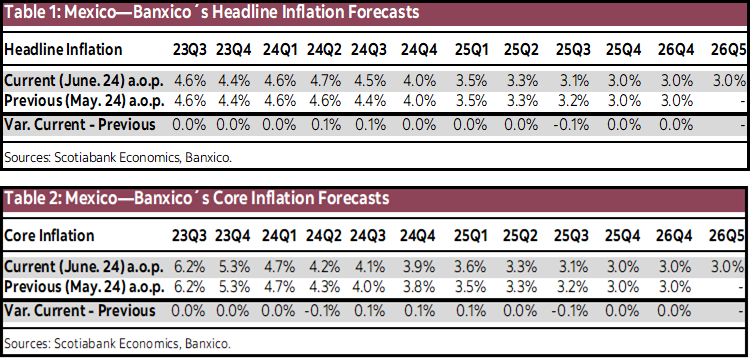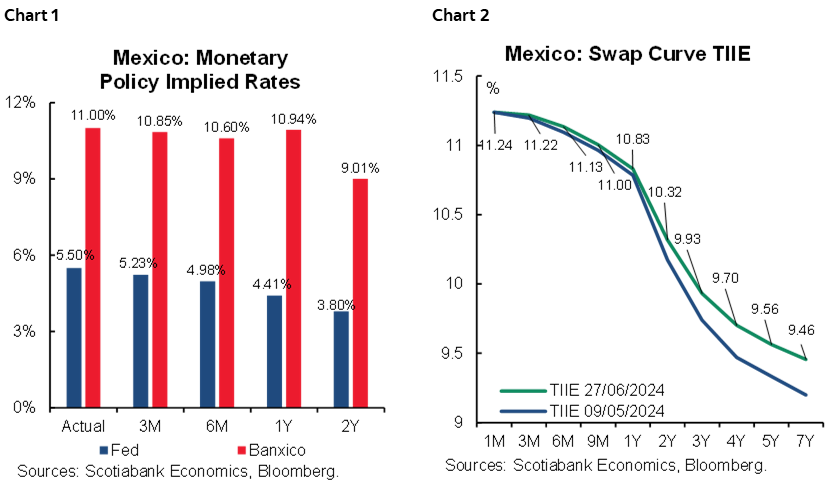- Banxico’s Governing Board kept the rate unchanged at 11.0% in a 4–1 split vote.
- The dissenting vote was by Omar Mejia in favour of a 25bps cut.
- The statement considered that recent economic weakness partly offset the inflationary effect of the currency depreciation.
- The dovish tone opens the door to an additional cut at the August meeting.
- Implied rates converge to two cuts in the remainder of the year, in line with our expectation of a rate at 10.50% by the end of 2024.
As widely expected, Banxico’s Board of Governors left the interest rate unchanged at 11.0% but in a split 4–1 vote, with Omar Mejia dissenting in favour of a 25bps cut. The statement showed a dovish tone, opening the door to a cut at the next meeting in August.
According to the statement, “although the depreciation of the Mexican peso impacts the inflation forecast upwards, its effects are partly offset by those associated with the greater weakness exhibited by economic activity.” In this sense, the Board of Governors considered that the balance of risks for economic activity is biased to the downside. On the other hand, it estimated that the inflation outlook remains subject to upside risks. Thus, Banxico revised up its inflation forecasts, albeit only marginally given recent economic weakness. The Board still expects inflation to converge to the 3.0% target by the end of 2025. The headline inflation expectation rose slightly in the short term (table 1), while the core inflation forecast suffered mixed changes over the forecast horizon (table 2). The upside risks to their forecasts were: 1) persistence of core inflation; 2) greater foreign exchange depreciation; 3) greater cost-related pressures; 4) climate-related impacts, and 5) the intensification of geopolitical conflicts. On the downside, the risks considered are: 1) weaker-than-anticipated economic activity; 2) a lower pass-through effect from some cost-related pressures, and 3) a lower-than-anticipated effect of the peso’s depreciation on inflation.

After the release of the statement, the implied monetary policy rate slightly moved to 10.60% in the six-month period, moving from one to two cuts expected for the remainder of the year, although this could change if core inflation and economic growth continue to fall, considering the dovish tone of the statement (chart 1). On the TIIE curve, long-term rates have been on the rise so far this year, reacting to the change in expectations, as the cutting cycle was previously expected to be more aggressive (chart 2). For the US, the implied rate has also been dropping, suggesting two cuts by the end of the year, although the tone of the FOMC has been more hawkish given the persistence of inflation and higher-than-expected growth. For the second half of 2024, we foresee volatility in local financial markets, particularly between September and November, owing to political developments related to the announced reforms and the 2025 fiscal budget in Mexico, and the elections in the US. This will create uncertainty regarding future decisions by both countries’ central banks.

In our view, the dovish tone of the statement opens the door to an additional cut at the August meeting. However, we believe that the outlook faces a high degree of uncertainty, due to the behaviour of inflation, especially in its non-core items, as well as the political events that could foster volatility and risk aversion in financial markets. Thus, we maintain our expectation of a cut at the September meeting, and a rate of 10.50% in December of this year, with a data-dependent focus.
DISCLAIMER
This report has been prepared by Scotiabank Economics as a resource for the clients of Scotiabank. Opinions, estimates and projections contained herein are our own as of the date hereof and are subject to change without notice. The information and opinions contained herein have been compiled or arrived at from sources believed reliable but no representation or warranty, express or implied, is made as to their accuracy or completeness. Neither Scotiabank nor any of its officers, directors, partners, employees or affiliates accepts any liability whatsoever for any direct or consequential loss arising from any use of this report or its contents.
These reports are provided to you for informational purposes only. This report is not, and is not constructed as, an offer to sell or solicitation of any offer to buy any financial instrument, nor shall this report be construed as an opinion as to whether you should enter into any swap or trading strategy involving a swap or any other transaction. The information contained in this report is not intended to be, and does not constitute, a recommendation of a swap or trading strategy involving a swap within the meaning of U.S. Commodity Futures Trading Commission Regulation 23.434 and Appendix A thereto. This material is not intended to be individually tailored to your needs or characteristics and should not be viewed as a “call to action” or suggestion that you enter into a swap or trading strategy involving a swap or any other transaction. Scotiabank may engage in transactions in a manner inconsistent with the views discussed this report and may have positions, or be in the process of acquiring or disposing of positions, referred to in this report.
Scotiabank, its affiliates and any of their respective officers, directors and employees may from time to time take positions in currencies, act as managers, co-managers or underwriters of a public offering or act as principals or agents, deal in, own or act as market makers or advisors, brokers or commercial and/or investment bankers in relation to securities or related derivatives. As a result of these actions, Scotiabank may receive remuneration. All Scotiabank products and services are subject to the terms of applicable agreements and local regulations. Officers, directors and employees of Scotiabank and its affiliates may serve as directors of corporations.
Any securities discussed in this report may not be suitable for all investors. Scotiabank recommends that investors independently evaluate any issuer and security discussed in this report, and consult with any advisors they deem necessary prior to making any investment.
This report and all information, opinions and conclusions contained in it are protected by copyright. This information may not be reproduced without the prior express written consent of Scotiabank.
™ Trademark of The Bank of Nova Scotia. Used under license, where applicable.
Scotiabank, together with “Global Banking and Markets”, is a marketing name for the global corporate and investment banking and capital markets businesses of The Bank of Nova Scotia and certain of its affiliates in the countries where they operate, including; Scotiabank Europe plc; Scotiabank (Ireland) Designated Activity Company; Scotiabank Inverlat S.A., Institución de Banca Múltiple, Grupo Financiero Scotiabank Inverlat, Scotia Inverlat Casa de Bolsa, S.A. de C.V., Grupo Financiero Scotiabank Inverlat, Scotia Inverlat Derivados S.A. de C.V. – all members of the Scotiabank group and authorized users of the Scotiabank mark. The Bank of Nova Scotia is incorporated in Canada with limited liability and is authorised and regulated by the Office of the Superintendent of Financial Institutions Canada. The Bank of Nova Scotia is authorized by the UK Prudential Regulation Authority and is subject to regulation by the UK Financial Conduct Authority and limited regulation by the UK Prudential Regulation Authority. Details about the extent of The Bank of Nova Scotia's regulation by the UK Prudential Regulation Authority are available from us on request. Scotiabank Europe plc is authorized by the UK Prudential Regulation Authority and regulated by the UK Financial Conduct Authority and the UK Prudential Regulation Authority.
Scotiabank Inverlat, S.A., Scotia Inverlat Casa de Bolsa, S.A. de C.V, Grupo Financiero Scotiabank Inverlat, and Scotia Inverlat Derivados, S.A. de C.V., are each authorized and regulated by the Mexican financial authorities.
Not all products and services are offered in all jurisdictions. Services described are available in jurisdictions where permitted by law.

